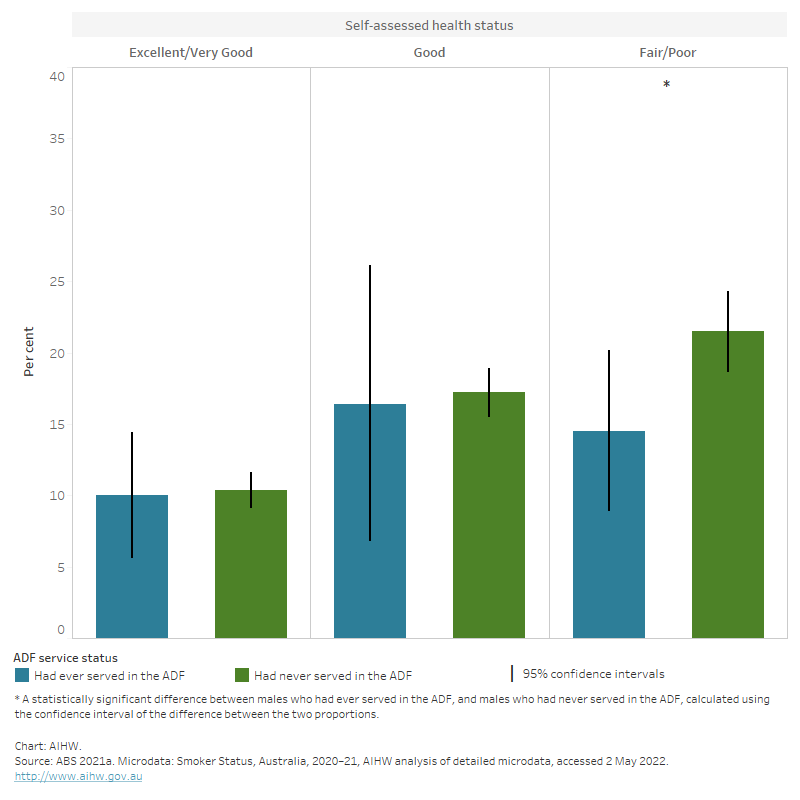Self-assessed health status
Self-assessed health status is a commonly used measure of overall health, and reflects a person's perception of their own health at a given point in time (ABS 2018). As a self-reported measure, it captures the combined effects of physical, social, emotional, and mental health and wellbeing.
Analysis of the ABS Smoker Status, Australia 2020–21 data set indicated that in 2020–21, for males aged 18 years and over who had ever served in the ADF:
- rates of current smoking were similar across all self-assessed health categories.
- those who rated their health as fair or poor were less likely to be current smokers than those who had never served and rated their health as fair or poor (15% compared with 22%, respectively).
Among those who had never served in the ADF, rates of current smoking increased as self-assessed health status decreased (Figure 5).
Figure 5: Current smoker status of males, by self-assessed health status and ADF service status, 2020–21
The bar chart shows that males who rated their health as fair or poor were less likely to smoke if they had served in the ADF.

ABS (Australian Bureau of Statistics) (2018) Self-assessed health status, ABS, Australian Government, accessed 20 May 2022.
ABS (2020) General Social Survey: Summary Results, Australia methodology, ABS, Australian Government, accessed 02 June 2022.
ABS (2021a) Microdata: Smoker Status, Australia, 2020–21, AIHW analysis of detailed microdata, accessed 2 May 2022.
ABS (2021b) Education and work, Australia, ABS, Australian Government, accessed 2 August 2022.
AIHW (Australian Institute of Health and Welfare) (2020) National Drug Strategy Household Survey 2019, AIHW, Australian Government, accessed 14 July 2022.
Daraganova G, Smart D and Romaniuk H (2018) Transition and Wellbeing Research Programme Family Wellbeing Study. Part 1: Families of current and ex-serving ADF members: health and wellbeing, Defence and Department of Veterans’ Affairs, Australian Government, accessed 2 August 2022.
Hummel K, van den Putte B, Mons U, Willemsen M, Fong G, Andler R, de Vries H, and Nagelhout G (2019) The role of income and psychological distress in the relationship between work loss and smoking cessation: Findings from three International Tobacco Control (ITC) Europe countries, Tobacco Prevention and Cessation, 5(42), doi: 10.18332/tpc/113092.
Lawrence-Wood E, McFarlane A, Lawrence A, Sadler N, Hodson S, Benassi H, Bryant R, Korgaonkar M, Rosenfeld J, Sim M, Kelsall H, Abraham M, Baur J, Howell S, Hansen C, Iannos M, Searle A, and Van Hooff M (2019) Impact of combat report, Defence and Department of Veterans’ Affairs, Australian Government, accessed 2 August 2022.
Minkkinen J, Kinnunen J, Karvonen S, Hotulainen R, Lindfors P, and Rimpelä A (2018) Low schoolwork engagement and schoolwork difficulties predict smoking in adolescence?’, European Journal of Public Health, 29(1), doi: 10.1093/eurpub/cky179.
Wells L, Östberg V (2021) ‘How do educational disparities in smoking develop during early life? A Swedish longitudinal study’, SSM – Population Health, 15, doi: 10.1016/j.ssmph.2021.100859.
Wood L, Greenhalgh EM and Hanley-Jones S (2019) 5.9 The educational environment: achievements, aspirations and ‘school connectedness’, Cancer Council Victoria, accessed 23 May 2022.


